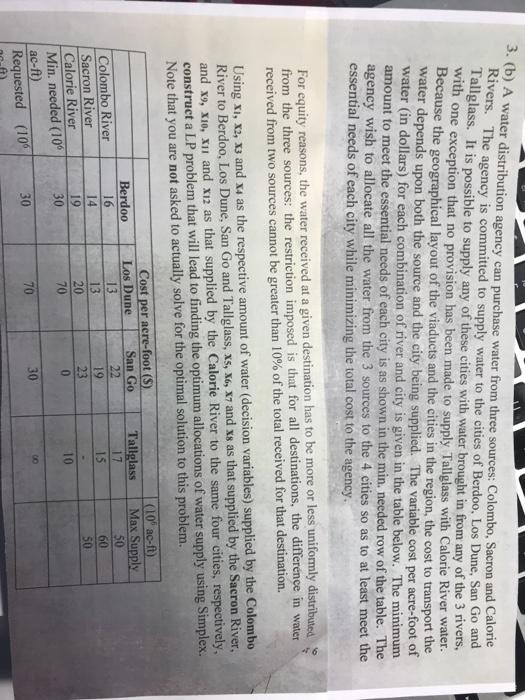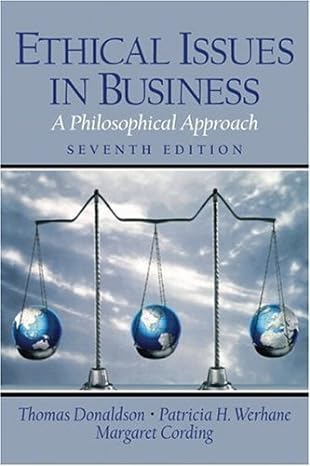3. (b) A water distribution agency can purchase water from three sources: Colombo, Sacron and Calorie Rivers. The agency is committed to supply water to the cities of Berdoo, Los Dune, San Go and Tallglass. It is possible to supply any of these cities with water brought in from any of the 3 rivers, with one exception that no provision has been made to supply Tallglass with Calorie River water. Because the geographical layout of the viaducts and the cities in the region, the cost to transport the water depends upon both the source and the city being supplied. The variable cost per acre-foot of water (in dollars) for each combination of river and city is given in the table below. The minimum amount to meet the essential needs of each city is as shown in the min. needed row of the table. The agency wish to allocate all the water from the 3 sources to the 4 cities so as to at least meet the essential needs of each city while minimizing the total cost to the agency. For equity reasons, the water received at a given destination has to be more or less uniformly distributed from the three sources: the restriction imposed is that for all destinations, the difference in water received from two sources cannot be greater than 10% of the total received for that destination. Using XI, X2, 13 and x4 as the respective amount of water (decision variables) supplied by the Colombo River to Berdoo, Los Dune, San Go and Tallglass, xs, X6, x7 and xs as that supplied by the Sacron River, and x9, X10, XII and xi2 as that supplied by the Calorie River to the same four cities, respectively, construct a LP problem that will lead to finding the optimum allocations of water supply using Simplex. Note that you are not asked to actually solve for the optimal solution to this problem. Tallglass 17 15 Cost per acre-foot (S) Los Dune San Go 13 22 13 19 20 23 70 0 Berdoo 16 14 19 30 (10" ac-ft) Max Supply 50 60 50 Colombo River Sacron River Calorie River Min. needed (10 ac-ft) Requested (100 10 30 8 30 70 3. (b) A water distribution agency can purchase water from three sources: Colombo, Sacron and Calorie Rivers. The agency is committed to supply water to the cities of Berdoo, Los Dune, San Go and Tallglass. It is possible to supply any of these cities with water brought in from any of the 3 rivers, with one exception that no provision has been made to supply Tallglass with Calorie River water. Because the geographical layout of the viaducts and the cities in the region, the cost to transport the water depends upon both the source and the city being supplied. The variable cost per acre-foot of water (in dollars) for each combination of river and city is given in the table below. The minimum amount to meet the essential needs of each city is as shown in the min. needed row of the table. The agency wish to allocate all the water from the 3 sources to the 4 cities so as to at least meet the essential needs of each city while minimizing the total cost to the agency. For equity reasons, the water received at a given destination has to be more or less uniformly distributed from the three sources: the restriction imposed is that for all destinations, the difference in water received from two sources cannot be greater than 10% of the total received for that destination. Using XI, X2, 13 and x4 as the respective amount of water (decision variables) supplied by the Colombo River to Berdoo, Los Dune, San Go and Tallglass, xs, X6, x7 and xs as that supplied by the Sacron River, and x9, X10, XII and xi2 as that supplied by the Calorie River to the same four cities, respectively, construct a LP problem that will lead to finding the optimum allocations of water supply using Simplex. Note that you are not asked to actually solve for the optimal solution to this problem. Tallglass 17 15 Cost per acre-foot (S) Los Dune San Go 13 22 13 19 20 23 70 0 Berdoo 16 14 19 30 (10" ac-ft) Max Supply 50 60 50 Colombo River Sacron River Calorie River Min. needed (10 ac-ft) Requested (100 10 30 8 30 70







